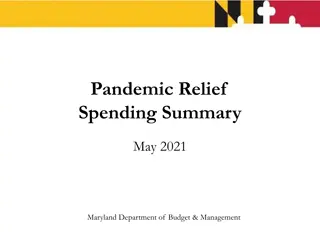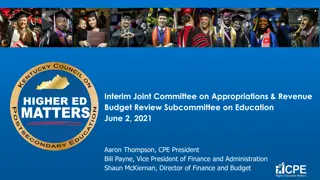Understanding Linking Relief, Rehabilitation, and Development (LRRD) Approach
Linking Relief, Rehabilitation, and Development (LRRD) aims to connect short-term relief efforts with long-term development strategies, creating synergy for a sustainable crisis response. Established in the 1980s to address funding gaps and food crises, LRRD emphasizes principles of Good Humanitarian Donorship and aims to reduce the need for emergency relief through proactive measures like conflict prevention and disaster risk reduction. By integrating relief and development activities, LRRD seeks to enhance community resilience and promote sustainable livelihoods.
Download Presentation

Please find below an Image/Link to download the presentation.
The content on the website is provided AS IS for your information and personal use only. It may not be sold, licensed, or shared on other websites without obtaining consent from the author. Download presentation by click this link. If you encounter any issues during the download, it is possible that the publisher has removed the file from their server.
E N D
Presentation Transcript
Linking Relief, Rehabilitation, and Linking Relief, Rehabilitation, and Development (LRRD) Development (LRRD) Uzma Shahid
What it Means and What Type of Activities are Mostly Planed in Different Phases Relief Rehabilitation Development
The Concept of LRRD has Figured on the International Agenda for Decades It originated in the 1980s- (funding gap- identified by the practitioners and academic food crisis in Africa) LRRD is to link short-term relief measures with longer term development programmes in order to create synergies and provide a more sustainable response to crisis situations.
Principles Good Humanitarian Donorship, Humanitarian assistance should be provided in 'ways that are supportive of recovery and long-term development, striving to ensure support, Where appropriate, to the maintenance and return of sustainable livelihoods and transitions from humanitarian relief to recovery and development. In turn, well-designed development cooperation programmes should reduce the need for emergency relief, and LRRD development activities should include measures for conflict prevention, disaster risk reduction, disaster preparedness and the development of early warning systems.
Purpose Better development can reduce long-term relief needs, while well-targeted relief programs can support community development. To reinforce existing aid structures and cultures where disasters
The Concept has Evolved over Time and Today Implies Adopting A Continuum Approach. Initially, LRRD was conceived as a linear continuum sequence: rehabilitation would follow the relief phase, to be succeeded in turn by classic development co-operation. However, experience from the 1990s demonstrated that treating relief, rehabilitation and development as separate processes failed to respond to the complexity of a number of crisis situations. In certain cases, such as protracted or post-conflict situations, the changing nature of the operational environment makes it difficult to adopt each response separately and in turn. As a result, the continuum approach was abandoned in favor of a continuum approach, which departs from a scenario of simultaneous and complementary use of different aid instruments. Since 2000, security policy actors have entered the debate on LRRD and provided another perspective. Privileging questions related to security transition, these actors call for a more comprehensive approach to ensure greater coherence between security, development and humanitarian assistance.
Emergency relief and development should not be regarded as alternatives; one provides a starting point and a foundation for the other. Relief requirements must be met in a way which form the outset provides a foundation for lasting development (UN Secretary General, 1995)
Continuum Paradigms Continuum refer to a process wherein there is linear link between the relief, rehabilitation and development activities. Clear moments of intervention: the relief phase, rehabilitation phase and development phase when relief and rehab phase over More focus on the relief activities and helping to alleviate the suffering of the people and little attention to give the pre-crises situation.
Continuum Paradigms Continuum does not define the disaster crises in term of sequences but views emergency or disaster response as two pronged approach. It is holistic response based on integral development right from the beginning. More integral and less compartmentalized. Specific intervention unite in order to take into account the relief, rehab and development aspects in the implementation strategies Development activities are natural outcomes of relief and rehab
Is it a New Agenda? The Nexus is a continuation of long-running efforts to link humanitarian and development actions for the building of long term resilience, especially in protracted crises, complex emergencies or situations of chronic vulnerability. This way of thinking began to take form in the Linking Relief, Rehabilitation and Development (LRRD) approach, which emerged in the 1990s and then taken up in resilience discussions as of the early 2000s. LRRD is an approach to programming that focuses on a better transition between humanitarian, rehabilitation and development activities. However, it has been criticized for being too linear in nature. With global displacement and humanitarian needs soaring as of 2012, emergencies have become protracted and assistance is needed to address both short-term and long-term vulnerabilities.
The focus of the international community thus has shifted towards resilience and conflict prevention in order to bring to an end the cycle of aid dependency or reduce the possibility of fragility and conflict in the first place. To achieve such goals, the international community has recognized that Humanitarian and development actors need to coordinate better and work more efficiently, New funding mechanisms need to be created, The approach to providing aid needs to change. UN-led initiatives for the new ways of working include collective outcomes, comparative advantages and multi-year frameworks. Peace was added as a third pillar inherently tied to the success of the long-term sustainability and impact humanitarian and development assistance. The humanitarian-development-peace Nexus is a framework that goes beyond a single program and encompasses all these changes: better collaboration between actors, complementary and coherent responses, prevention, and changes in financing mechanisms.
The Renewed Interest in LRRD Resilience Coordinating response strategies to enhance resilience, Focusing humanitarian and development assistance on respective comparative advantages, Exploiting the flexibility offered by existing financing instruments, encouraging 'cross-learning' of humanitarian and development experiences in projects supporting resilience, Organizing early exchanges of information and opinions between humanitarian and development services on all proposed 'resilience' programmes and projects
The Proposed Question While Developing The Program 1. What specific strategies do programs employ to link Humanitarian and Development interventions at program planning/design and operational levels? 2. Are the factors that support/enable program outcomes and LRRD operational linkages defined? 3. Are the factors that disenable program outcomes and LRRD operational linkages defined? 4. What are the forecast impacts of these interventions (e.g. program assessments, beneficiary impact assessments, developed outcome measures), including specific contributions of effective phase linkage to program outcomes?
Needed for Organizations Capacity building of your management and staff on LRRD culture at the both pre crises moment and post crisis moment Build capacity of staff to work with integral perspective, this means the DRR activities must be shared with regular development staff especially the field staff Work with networks, where discussion take place on the issue systematic reflection and sharing good practices Design the integrated program to address all the risk prevailing around and faced in past. Take up lobby with donor Funding partners etc.























